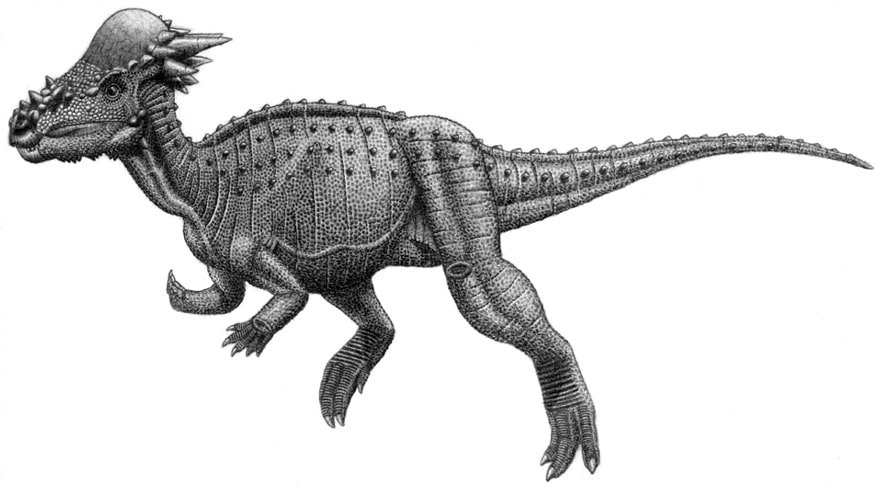
Stygimoloch is one of the more recent additions to the diaspora of paleontology. These resident dinosaurs not only have a curious name root, but were also remarkable in their small size relative to the time in which they lived.
In 1983, British paleontologist Peter M. Galton and German paleontologist Hans-Dieter Sues first described Stygimoloch. Fossils were discovered in the Hell Creek Formation in Montana, followed by finds in Wyoming.
Although further research is underway, there are many theories surrounding these dinosaurs from North America that lived about 65 million years ago, in the late Cretaceous period.
| Profile | Stygimoloch |
|---|---|
| Prehistoric Era | Upper Cretaceous, 69.9 to 66 million years ago. |
| Order | Ornithischia |
| Suborder | Cerapoda |
| Family | Marginocephalia |
| Tribe | Pachycephalosauridae |
| Genus | Stygimoloch |
| Species | Stygimoloch spinifer |
| Height | 1.7 meter |
| Length | 3 - 5 meter |
| Weight | 450 kg |
| Territory | USA, North Dakota, Wyoming and Montana |
Stygimoloch is a herbivore or possibly an omnivore and belongs to the genus Pachycephalosaurs. It got its name because of the fearsome appearance of its domed, spiny, and thick skull.
The name stygimoloch has two word roots. The first, Stygi, comes from the Greek myth of Chiron, the ferryman of the river Styx. The last part, Moloch, comes from an ancient Hebrew god of the same name.
Stygimoloch was a small to medium sized creature with an estimated average length of about 3 - 5 meters and a weight of 45 kg. This makes it almost twice the size of an adult human. But unlike others in the Pachycephalosauria family, Stygimoloch was smaller and shorter. Stygimoloch spinifer was a bipedal dinosaur from the order of avian dinosaurs (Ornithischia). It had a large, powerful pelvic region and long muscular hind legs. The upper body was lighter with a small and light head. Its tail, stiffened by ossified tendons, was held horizontally when it ran, serving as a counterweight.
This physique allowed this dinosaur to move quickly and agilely. An advantage when hunting. It is possible that he had a powerful jumping or hopping gait.
The unusual feature of Stygimoloch was its thickened skullcap. This was formed from the fused frontal and parietal bones. This crest was clearly bulging and pointed.
The skull was covered with numerous small bony horns.
The two longest were on the back of his head. They were about 10 cm long and pointed backwards.
They might have served for defense against predators.
The function of the domed skullcap and horns is debated among paleontologists.
The assumption that these dinosaurs performed ramming duels is not considered very likely by scientists. For these intra-species fights the skull dome is too pointed and therefore the impact area is too small.
Possibly the opponents tried to attack the flanks of the opponent.
Another line of thought assumes that the dome and the horns served for display and played a role in mate selection and identification.
Scientists have reason to believe that the dome develops with maturity and that juvenile stygimoloches had a flatter surface on the top of the head. However, the posterior horns were more prominent in the younger stygimoloch than in older ones.
Although many researchers consider that they were herbivores, there are some who believe this bizarre dinosaur was an omnivore.
Its teeth were small and serrated. Thus, they were not capable of chewing tough and fibrous plant material. Based on this fact, paleontologists assume that Stygimoloch ate a mixed diet of seeds, leaves, and fruits.
The front teeth were blade-like and serrated, reminiscent in shape of the teeth of carnivorous theropods. This leads to the assumption that this dinosaur also ate meat.
Stygimoloch may have eaten many flowering plants and, while foraging for plants and other plant food, may have eaten eggs that fell from nests, small marsupials, and early mammals. Snails and insects were also possible components of its regular diet.
This epic dinosaur deserves to be studied further. As mentioned above, additional research and discoveries about Stygimoloch are needed, because most of what we know about him is still theory and so far not fact.
Image source: Jordan Mallon, CC BY-SA 2.5 https://creativecommons.org/licenses/by-sa/2.5, via Wikimedia Commons
Skull reconstruction: Haplochromis, CC BY-SA 3.0 https://creativecommons.org/licenses/by-sa/3.0, via Wikimedia Commons
Size Comoarison: Nobu Tamura email:nobu.tamura@yahoo.com http://spinops.blogspot.com/, CC BY-SA 4.0 https://creativecommons.org/licenses/by-sa/4.0, via Wikimedia Commons
Skull (Lebka): Meridas (Vladimír Socha), CC BY-SA 4.0 https://creativecommons.org/licenses/by-sa/4.0, via Wikimedia Commons